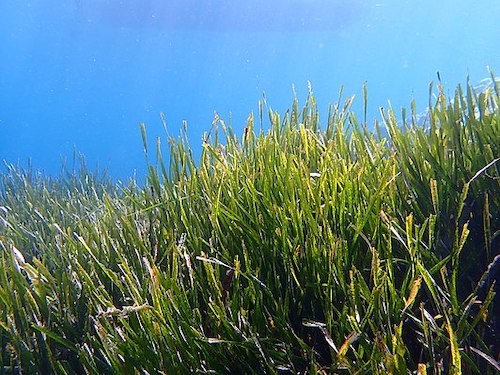(Posidonia oceanica. Photo: Wikipedia)
In May the gods were like drunkards and held the summer at a distance, whilst on the other hand, Chloris, the goddess of flowers, went completely crazy. Many years ago she was abducted by Zephyrus, god of the western wind and she later married him. On the left in a famous painting by Sandro Botticelli, you see the happy couple assisting at the birth of Venus, Roman goddess of Love. Chloris probably was the one that changed some young men into spring flowers, like Crocus, Hyacinth and Narcissus.
While the fields, orchards and even woods of Lesvos were a colourful orgy of flowers, fields underwater also filled with flowers and scientists roam along the shores to look for its fruit. There actually is a sea plant that flowers and produces fruit: Posidonia oceanica, a seagrass growing in thick woods at the sea bottom and which once in every 5 to 10 years produces so-called ‘sea olives’. The last time they were registered flowering was in spring 2013.
The grass is named after Poseidon, one of the big twelve Greek gods of Olympus. He ruled over oceans, storms, earthquakes and was the god of the horses – so perfect, you would think, to hold a special position on Lesvos: the island is surrounded by sea, sometimes woken by strong winds or a trembling earth and here there is a great love of horses.
Poseidon had a difficult start. His father Cronus was so afraid that one of his children would throw him off his throne that he ate all of them. Poseidon was the fifth child. After him came Zeus, but by then his mother Rhea was so fed up with Cronus and his cruel voracity that she hid Zeus in a cave were he was brought up by nymphs. Later Zeus would give his father a potion making him spew out all of this children alive.
Poseidon never became very popular. In the competition for the title of patron saint of the Greek capital, he lost to Athena who brought an olive tree, while Poseidon had produced a spring, however with salty water.
Maybe Poseidon practised drilling his water wells on Lesvos and maybe his spring in Athens was sabotaged – for from the many wells on Lesvos comes cool and sweet water. But, even so, those springs didn’t make Poseidon a hero. As far as I know on Lesvos you could find temples for only Zeus (Messa), Dionysus (Messa and Fokas), Cybele (Messa) and Apollo (Klopedi).
Poseidon with his famous trident did not even manage to give his name to his favourite haunt: the Aegean sea. But for now he can be proud of his seagrass forests, even though some nick names for Posidonia oceanica are Neptunes grass or Mediterranean Tapeweed. Nowadays The Meadows of Poseidon form a measurement for the quality of the environment: they collect polluting materials between their leaves and are very sensitive to climate changes. Moreover they are the biggest producers in the world of oxygen, they protect coasts and are a rich habitat for all kind of sea creatures and plants.
The ancient Greeks used to make a beauty cream from fine seagrass and water. Minoan women mixed mulberries, flowers and seagrass to put some rouge on their cheeks and even now Posidonia oceanica is an important ingredient for the beauty industry. Not long ago a street vendor in Athens decided to put seagrass into a mattress. He now has several bedding shops all over the world (Coco-mat). Another Greek business uses seagrass in sunglasses, phone covers and boxes (PHEE and Zeyelo).
On Lesvos, an island surrounded by sea grass meadows, Poseidon oceanica is mostly used as fertilizer: left for a winter to de-salt through the wind and the rains in spring, it becomes rich food to spoil plants. Many beaches are covered with thick layers of dried brown trails, so easy to grasp. Most people do not like such beaches, not realising what healthy ground it is when spreading a beach towel over it: it might tickle a bit, but it is lovely soft and warm.
Entire armies of tourists have been feasting upon the incredible beautiful flower wealth and whistling birds on the island this May, but the sporadic flowering Meadows of Poseidon remained a deep secret.











